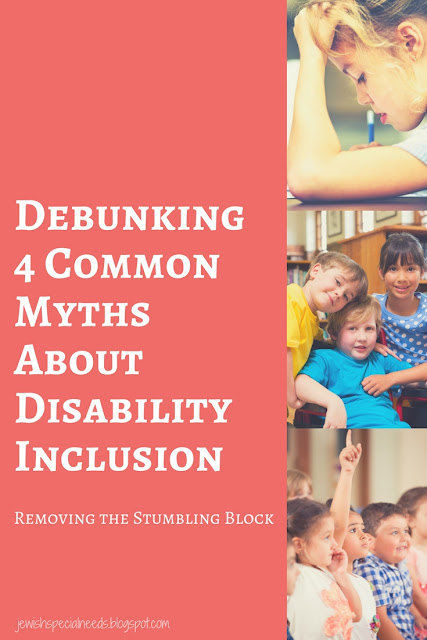Inclusion: the action or state of including or being included within a group or structure
However, interpretations and approaches vary widely. I believe that inclusion is a state of mind, a belief system that guides us to ensure a true sense of belonging. Inclusive education is ensuring that ALL students have equal access to curriculum and meaningful learning experiences.
Nevertheless, there is no blueprint for how to make this happen on a practical level in schools. As a result, each state, district, school, and even teacher may have a slightly different understanding of what an inclusive classroom is, let alone how to create one.
Below are the four most common myths and misconceptions that have become barriers to the widespread implementation of inclusive education.
Myth #1: Inclusion holds back the typically-able students.
A classroom rich with activities to challenge and support children — regardless of their academic abilities — maximizes the potential for success across the board.Students should not be compared with one another, nor should they be subjected to arbitrary levels of expected achievement. In a truly inclusive classroom, no student is held back or exposed to content that does not challenge her in some way. Instead, every learner has an equal opportunity to grow and achieve.
Research suggests that disabled students in inclusive classrooms show greater academic progress than in segregated classrooms. One study, which tracked more than 1,300 6- to 9-year-olds with disabilities who attended school across 180 different districts, suggests “a strong positive relationship between the number of hours students spent in general education and achievement in mathematics and reading.” Furthermore, students with intellectual disabilities who were fully included in general education classrooms made more progress in literacy skills when compared to students in special education programs.
 With respect to inclusion and students without disabilities, research shows
that their performance is not negatively impacted, and, in fact, that they reap
“several social benefits” from the experience. A more recent study
reinforces these findings: “[T]here is now sufficient evidence to
suggest that typical peers are not harmed by or disadvantaged in
inclusive classrooms.” As in the earlier study, this one
shows that students without disabilities demonstrated “improved
pro-social behaviors,” and that they enjoyed “the opportunity to become
experts in academic areas” while helping their disabled peers.
With respect to inclusion and students without disabilities, research shows
that their performance is not negatively impacted, and, in fact, that they reap
“several social benefits” from the experience. A more recent study
reinforces these findings: “[T]here is now sufficient evidence to
suggest that typical peers are not harmed by or disadvantaged in
inclusive classrooms.” As in the earlier study, this one
shows that students without disabilities demonstrated “improved
pro-social behaviors,” and that they enjoyed “the opportunity to become
experts in academic areas” while helping their disabled peers.Myth #2: Individualized expectations for a child with disabilities isn’t fair to the other students.
Fairness, as a concept, ensures that each student receives the support he needs to be academically successful. However, fairness is so very often confused with equality.Individualizing expectations does not take anything away from capable students. Rather, it demonstrates flexibility and a willingness to embrace a wide variety of needs within a school community. Children may question why another student got full credit for what they perceive as doing less, but it is up to teachers, parents, and administrators to effectively explain and demonstrate ways to both welcome and celebrate differences.
Myth #3: One student’s negative behavior can ruin a whole class.
This is a big one in so many classrooms. And the honest answer is that negative behavior can interfere with a class dynamic if the teacher lets it. Teachers have a responsibility to get to know their students personally and build positive relationships with them in order to manage student behavior in a way that provides all students with a warm, supportive, challenging, and meaningful environment. Managing a classroom effectively takes skill and practice.Teachers who focus on developing interpersonal relationships with students are more effective in teaching them to demonstrate positive, socially-appropriate behaviors. Teachers must learn various techniques and strategies to support every student, though there is no one-size-fits-all approach to accomplish these goals.
Myth #4: Inclusion costs a lot more money.
There are inexpensive ways to be sure that a school community is inclusive. First and foremost is to model an inclusive attitude from the top down.Leaders shape the culture of a school community through the way they act and treat faculty, students, parents, and support staff. Demonstrating inclusiveness is simultaneously cost-effective and priceless in the atmosphere it creates.
Other cost-effective strategies include investing in high-quality professional development for teachers and other school staff — training that teaches everyone how to welcome, accept, and embrace diversity in a school community.
Myths are perpetuated by a lack of understanding. It is the responsibility of educational professionals to recognize the myths that may lead to flaws within our current structures and systems.When we join in conversation with real-life examples and hands-on experiences, attitudes can change, myths can be eliminated, and every student can find success.

No comments:
Post a Comment